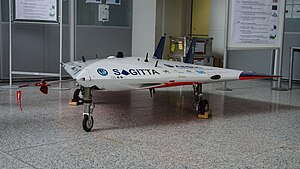SAGITTA (drone)
| Sagitta | |
|---|---|
 Sagitta at the DLRK 2017 |
|
| Type: | Test and research aircraft |
| Design country: | |
| Manufacturer: |
Airbus Defense and Space , DLR, THI, TUC, TUM, UniBw |
| First flight: |
5th July 2017 |
| Commissioning: |
In flight testing |
| Number of pieces: |
1 |
The test and research aircraft Sagitta ( Latin sagitta 'arrow') from Airbus Defense and Space is an unmanned flying test vehicle that was developed as part of the Open Innovation Initiative of Airbus together with German academic partners.
history
The aim of the Open Innovation Program Sagitta is to promote the continuous exchange between industry and research institutions in the field of technologies for unmanned aerial vehicles. In the research program started at the end of 2010, doctoral theses on various topics were started at the academic partners at the TU Chemnitz and TU Munich , the University of the Federal Armed Forces in Munich , the Technical University of Ingolstadt and the German Aerospace Center (DLR) in Braunschweig and Oberpfaffenhofen. At the same time, all partners jointly developed the unmanned test vehicle Sagitta to demonstrate technologies from the research program. The first flight took place on July 5, 2017 at the Overberg Test Range in South Africa.
development
Individual systems and components were developed and manufactured by the cooperation partners. The final integration and testing of the entire system took place in the Airbus military aviation center in Manching, Bavaria.
construction
The unmanned aerial vehicle has a wingspan and length of around 3.00 m each and a maximum weight of 150 kg. It is equipped with two BF-300F jet engines from BF Turbines, each with 300 N thrust. It offers space for various experiments from the research program.
The elevators, ailerons and rudders are operated electrically by actuators ( fly-by-wire ); the landing gear is also retracted electrically. The flight control system consists of a flight control computer, navigation (differential GPS in combination with an inertial platform) and air data processing. A mission computer was integrated for the mission tasks. The flight and the mission are monitored by a ground station.
The aircraft communicates via radio link. The flight is carried out fully automatically.
See also
- Cassidian Barracuda
- Dassault Neuron
- BAE Taranis
- General Atomics MQ-1 Predator
- Northrop Grumman / IAI RQ-5 Hunter
- IAI Heron , Northrop Grumman / AAI RQ-2 Pioneer , IAI Scout, IAI Searcher, IAI Skylite
Web links
- Successful first flight of UAV demonstrator SAGITTA, Airbus Press release
- SAGITTA successfully masters first flight, DLR press release
- Sagitta project website of the professorship for flight mechanics and flight guidance, UniBw Munich
- Sagitta project website of the professorship for aerospace engineering, UniBw Munich